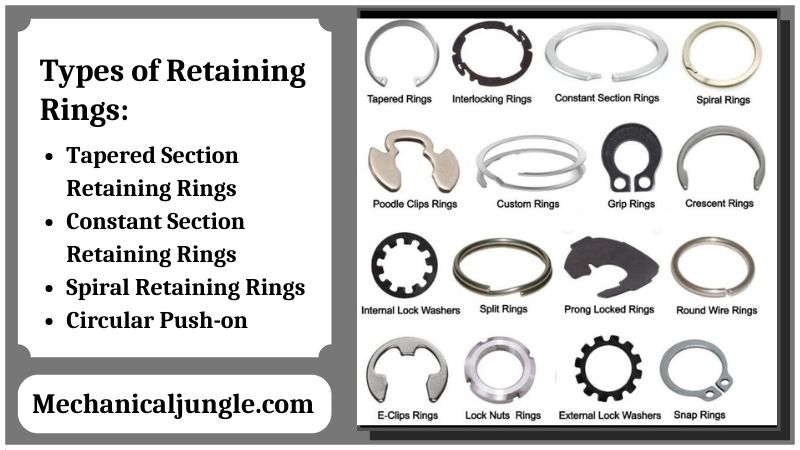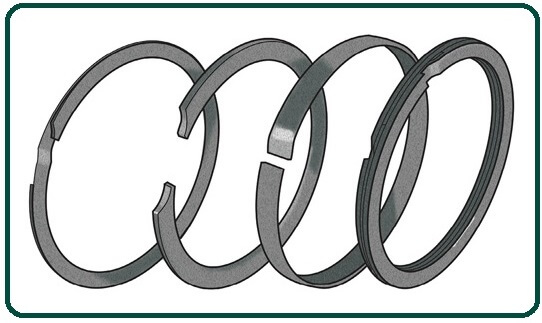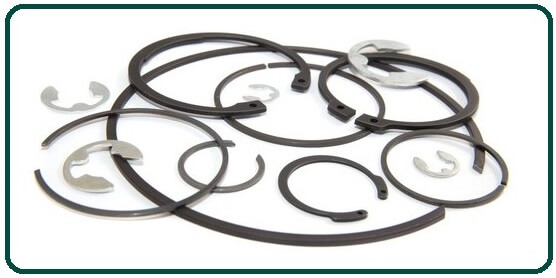
What Are Retaining Rings?

A retaining ring is an engineered component used to hold multiple types of assemblies together. They are precision-engineered to accurately position, locate and maintain parts in shafts or holes.
The rings are installed in a groove, and all other components of the assembly sit against and retain the ring. Retaining ring designs include spiral, tapered, and continuous sections.
Spirals rings do not have ears or lugs to interfere with the assembly like standard stamp rings. Tapered section rings have compressible lugs that give them a circular shape in the groove, allowing them to hold tightly to the edge.
Constant section retaining ring is best suited for heavy-duty applications. They feature a uniform, continuous section with no change in width throughout their circumference. Some special designs also exist, including very shallow grooves for use on thin-walled sections of components.
They help reduce costs by eliminating threading & other machining and offer less weight and size. In hydraulic systems, spiral retaining rings are often used on cylinders, especially to maintain sealed packing in the cylinder.
The retaining ring replaces machined “steps” to maintain packing. Additionally, retaining rings are also found in hydraulics couplers, hydraulics pumps, & other hydraulic components that require secure fastening. In pneumatics systems, they can be found in actuators, compressors, couplers, etc., to help fastens components as needed.
Standard materials for retaining rings include carbons steel, carbon spring steel, 302 stainless steel & 316 stainless steel. Other available materials include phosphor bronze, beryllium coppers, Inconel, alloy, Hastelloy, and more.
Rings that maintain a constant section, as the name implies, have a constant thickness around the circumference of the ring.
When installed, unlike tapered rings, continuous section rings do not maintain equal contact with the entire component. They take an elliptical shape and make contact with the component at certain points.
Spiral retaining rings are installed in the housing or on the shaft making full contact with the component. Die stamping is a traditional method of forming retaining rings, as well as newer methods such as coiling.
The ring can be made from varieties of materials, including carbon steel, stainless steel, and special alloys such as copper alloys. There are a few keys factors to consider in selecting a retaining ring.
One of the first may be the need to comply with any existing standards such as MIL or aerospace standards. These will help determine whether the retaining ring should be made of a particular material or operate under particular conditions.
Beyond any standard compliance issues, the most important and relevant variables are the diameter of the shaft or housing and the width and diameter of the groove. Chances are there may be existing types of ring grooves that have to be matched.
What Is a Retaining Ring, and Where Are They Used?

Retaining rings, also known as snaps rings or circles – are metal fasteners installed in a groove on shafts or in a housing or bores to retain an assembly. Tools hold parts in place using a compact, lightweight design that requires fewer machining operations than other fastening techniques.
Engineers specify retaining rings on an application basis:
- Installation and Removal Requirements
- Rotational Speed
- Conditions and Operating Environment
- Required Force Load on the Ring
- Cost
Retaining rings can range in size from 1mm to 1m in diameter. Different combinations of sizes, shapes, styles, and materials result in designs that work in a variety of industries and applications.
For example, a standard automobile may have more than 50 retaining rings in the system, including the powertrain, steering, and passenger protection.
Retaining rings are also used in many other applications, such as fitness types of equipment, wind turbine, bearing retentions, bicycles, doorknobs, gas pumps, office types of equipment, and many others.
#1. Design Considerations
The retaining ring can be classified into three main categories on the basis of design. Tapered and continuous section retaining rings describe a nearly perfect circle with a gap between the two free ends. The Tapered-section ring decreases in width from the top of the ring to the free end.
Installed, they make continuous contacts within their installation grooves. Some tapered-section rings designed for axial installation feature lugs that make them easier to extend and place. Conversely, rings of the consecutive sections have the same width across their circumference.
A tighter cross-section results in contact at three points within the installation groove. These simple, easy-to-make rings usually don’t have lugs. Spiral rings are made of flat wire that is coiled two or three times around the circumference.
They make 360-degree contact within their grooves and have a constant width around their circumferences. The spiral ring is rarely designed with installation lugs but instead have a notched end that aid in their removal.
#2. Meeting Demands
When choosing a retaining ring style, you’ll want to first consider the demands of the application. Some styles of tapered section rings provide a significant radial spring force that can handle high RPM applications and high loads.
However, others are much less suitable for higher speeds or forces, so be sure to check each style’s rating. Spiral rings work well with high loads and, in particular, in applications where dynamic loading requires flexibility.
Generally, spiral rings have lower RPM efficiencies than tapered section rings. However, some designs, such as spiral rings with patented locking features, keep the product firmly in place.
These tools are balanced and available in materials and styles that include light or heavy-duty, depending on the force load required.
Although fixed-section rings are typically used in applications with low load and speed requirements, several styles are available that can bear significant loads at a reasonable cost.
#3. Choosing Well
When choosing the ideal components, consider the preferred installations method & the frequencies with which you will be installing and removing the rings.
For example, the lugs on axially installed tapered-section retaining rings make them easy to install and uninstall with commonly available tools such as ring pliers. Keep in mind; designers must make sure they leave clearance for the lugs and room for the pliers to fit within the design.
Continuous-section rings are manufactured to ensure controlled edge positioning on the mating surface for less wear from sharp edges. The absence of lugs gives this style less clearance but requires a tapered mandrel or shank for installation. Spiral rings are also free of sharps edges.
They are the most difficult to installs, often by means of a tapered mandrel or taper – but they also offer the lowest clearances of the three style types.
Spiral rings are ideals for tamper-proofing. For easy removal, simply choose an end type that makes it easy to uninstall the spiral rings with a flat-head screwdriver.
The cost & availability of each style of retaining ring is also important considerations. The higher the load and movement capacity of the tapered section retaining ring, usually means higher the cost.
Continuous segment rings can offer a less expensive alternative to meet the performance requirements of an application. Since spiral rings are coiled with flat wire, their manufacture requires less tooling than stamped parts.
This means it is faster and more cost-effective to make spiral rings with custom shapes and sizes than other retaining ring styles.
Types of Retaining Rings:
#1. Tapered Section Retaining Rings
Tapered sections retaining the ring decrease symmetrically from the center to the free end, remaining circular when contracted or expanded within the range of normal use. This assures contact with the grooves along the entire circumference of the ring.
These rings can be installed axially horizontally along with the center point of the axis or radially externally along the radius of circles. Depending on the sizes of the rings in questions, they can be manufactured in one of two ways:
- For small rings: Use a die and stamping on the press with a steel or copper coil
- For larger rings: Wire making, in which rectangular wire is coiled and molded into a ring shape.
1.1. Axially Assembled
The axially assembled retaining ring is installed in a machined groove in the housing/bore internal or shaft external.
These rings are manufactured with lug holes, small holes in the lugs of both the axial inner and outer retaining rings, which are used to install/remove them using pliers designed for this purpose.
1.1.1. Inverted Retaining Rings
Inverted retaining rings are a form of axially assembled rings with holes in the rear to fit into the bottom of the groove.
Inverting lugs allow for greater clearance in the shaft or housing, and a highly uniform shoulder is good for maintaining large corner radii or chamfered bearings and other components.
1.1.2 Beveled Retaining Rings
Beveled retaining rings have a beveled or angled edge of 15°. This angle allows the ring to rotate itself between the groove and the retained part until it can no longer move, effectively “locking” everything in place. Think of putting a cork in a bottle.
The cork is then forced to open until it is rolled into the opening as closely as possible. The same thing happens when a beveled retaining ring is installed in an application. The ring is positioning itself between the groove wall and the remaining part, resulting in a rigid end-play called take-up.
1.1.3 Inclined Retaining Rings
Inclined retaining rings are curved versions of standard flat inner and outer retaining rings and apply a pre-load to the assembly when installed in the groove. This takes the end-play and acts like a spring, which holds the assembly in compression.
In manufacturing, parts cannot be produced to exact dimensions; As a result, if they are made at the lower part of the tolerance, they will come loose, or there will be a play on the shaft if a standard ring is installed.
If they are made on the highs side of the tolerances, they will extend further into the groove and prevents standard rings from being fully installed. Compensating for accumulated tolerances is what the inclined retaining rings are designed to do by acting as a spring once installed in the groove.
1.2 Radial Assembly
Radially assembled retaining rings are installed externally in machined grooves on a shaft. These rings have no holes and must be installed using an applicator.
1.3 Self-locking
Self-locking retaining rings can be installed on housing/bore or shafts that do not have grooves machined. A self-locking ring with no lug hole is impossible to remove without either dismantling the ring or turning it outside the specified tolerance.
#2. Constant Section Retaining Rings
The constant section retaining rings snap rings has a uniform constants section. In other words, the material used to make the ring is the same width at any point along the circumference of the ring. When they contract or expand, they take on an elliptical deformity.
As a result, they contact the grooves at three or more isolated points but not continuously around the circumference. These rings are made of either flat or round wire.
#3. Spiral Retaining Rings
Spiral retaining rings are installed axially into the housing/bore internal or shaft external, making 360° contact with the conduit. Spiral Retaining Rings have no ears or lugs to interfere with assembly.
These rings are manufactured by crimping flat wire into the shape of a finished retaining ring. Spiral rings are provided with a removal mark to simplify the removal process.
Spiral retaining rings can be produced economically in special alloys such as stainless steel because the manufacturing process eliminates scrap. No special tool is required for installation or removal. Duck-bill pliers can be used to install and remove outer spiral rings.
#4. Circular Push-on
A circular push-on ring resembling a toothed washer, usually made in metal. These are installed by pressing on the end of an oval shaft until the inner teeth of the nut are in the groove. The use of a push nut avoids the cost of threading a nut onto the end of the shaft during the manufacturing process.
Advantages of Retaining Rings:
- Less shaft/housing preparation threadings, tapping, drilling, etc.
- Low weight and size of the finished design
- Low cost of raw materials and labor
- Cheaper than other fastening methods
- Use fewer raw materials for a given size.
- Minimize and avoid complex machinings such as threads and under-cuts
- Compact design and quick assembly
- No special training is required for assembly.
- Lightweight and easy to install
- Significantly reduce production costs, unlike threaded options.
FAQ: Comprehensive Guide to Retaining Rings
What is a retaining ring?
A retaining ring is an engineered component used to hold multiple types of assemblies together. They are precision-engineered to accurately position, locate, and maintain parts in shafts or holes.
How are retaining rings installed?
Retaining rings are installed in a groove, with all other components of the assembly sitting against and retained by the ring. They can be installed axially or radially, depending on the design and application.
What are the different types of retaining rings?
There are several types of retaining rings, including:
- Tapered Section Retaining Rings
- Constant Section Retaining Rings
- Spiral Retaining Rings
- Circular Push-On Rings
What materials are commonly used to make retaining rings?
Standard materials include carbon steel, carbon spring steel, 302 stainless steel, and 316 stainless steel. Other available materials include phosphor bronze, beryllium copper, Inconel, alloy, Hastelloy, and more.
What factors should be considered when selecting a retaining ring?
Key factors include:
- Compliance with existing standards (e.g., MIL or aerospace standards)
- Diameter of the shaft or housing
- Width and diameter of the groove
- Application demands (e.g., load, speed, operating environment)
- Cost and availability of the retaining ring style
What are spiral retaining rings and how do they differ from other types?
Spiral retaining rings are made of flat wire coiled two or three times around the circumference. They make 360-degree contact within their grooves and have a constant width around their circumference, unlike other types that may have varying widths or tapered sections.
Where are retaining rings commonly used?
Retaining rings are used in a variety of applications, including:
- Automobiles (powertrain, steering, passenger protection)
- Fitness equipment
- Wind turbines
- Bearing retentions
- Bicycles
- Doorknobs
- Gas pumps
- Office equipment
- Hydraulic systems (cylinders, pumps, couplers)
- Pneumatic systems (actuators, compressors, couplers)
What are the advantages of using retaining rings?
Advantages include:
- Less shaft/housing preparation (e.g., no threading, tapping, drilling)
- Low weight and size of the finished design
- Low cost of raw materials and labor
- Compact design and quick assembly
- Reduced production costs compared to threaded options
- Ease of installation and removal with common tools
What are self-locking retaining rings?
Self-locking retaining rings can be installed on housings or shafts without machined grooves. They do not have lug holes and are impossible to remove without either dismantling the ring or turning it outside the specified tolerance.
How are constant section retaining rings different from other types?
Constant section retaining rings have a uniform width around their circumference and take on an elliptical shape when contracted or expanded. They contact the grooves at three or more isolated points, rather than continuously around the circumference like tapered or spiral rings.

